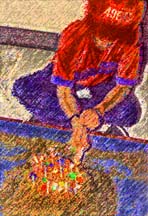
|

GUIDELINES FOR SETTING UP THE SANDTRAY

|

GUIDELINES FOR SETTING UP THE SANDTRAY
Excerpted
from Sandplay, The Sacred Healing, A Guide
to Symbolic Process
by Katie Amatruda, PsyD, MFT, CST-T, BCETS and Phoenix Helm Simpson, LMFT
Therapy
can happen anywhere as long as it is a safe place for the client and therapist.
With sandplay, however, specific guidelines will have to be followed.
Whether in private practice, community clinics, schools, hospitals or shelters,
look for the following:
* sand tray and collection of toys
* orientation training for staff who will use them, including personal sandplay
experience.
* a safe place for conducting sessions.
Figures
should include:
A. Animals: (Try to get animal families as well. Vary the size of
the animals - a huge lion expresses something very different than a small one.)
Wild: lions, tigers, panthers, zebras, bears, rhinos, elephants
Forest: deer, rabbits, bobcats, coyotes, wild boars, skunks
Domesticated: cats, dogs
Prehistoric: dinosaurs, mammoths
Fantasy: dragons, unicorns
Farm: cows, goats, chickens, sheep, horses, pigs
B.
Birds: ducks (air, land, water), owls, lovebirds, swans, birds in flight,
eagles, birds with nests, peacocks
C. Insects: butterflies, spiders, ants, caterpillars, miscellaneous bugs
D. Sea Creatures: fish, sharks, dolphins, octopi, whales
E.
Half-human- half- animals: centaurs, mermaids, satyrs
F.
Reptiles and amphibious creatures: frogs, crocodiles, snakes, lizards,
turtles
G. Monsters: large and small; include 2-headed monsters (which often appear when there is an alcoholic or inconsistent parent)
H. Food: include eggs, cakes, liquor and nourishing food
I. Fantasy Figures: witches and wizards, ,princes and princesses, kings and queens, magicians, fairytale and cartoon figures
J. Plants: trees [deciduous and evergreen, full and bare], flowers, seaweed, cacti (It is good to have a "special tree" which can symbolize the Tree of Life.)
K. Rocks and shells and fossils.
L. Mountains and caves, volcanoes.
M. Buildings: castles, houses, teepees, igloos, bridges
N. Barriers: screens, fences, signs
O.
Vehicles: cars, police, emergency and rescue vehicles,
trucks, fuel
P. People: Families - multicultural, elderly, adult, adolescent, children, babies. (Paint your figures if cannot find enough range in skin color.)
Action oriented figures, saints, shamans, skeletons, historical people
Q. Fighting figures: army soldiers, knights, cowboys and Indians, aliens
R. Spiritual: gods, shiny objects, candles, mandalas, mirrored objects, figures from different religions
S. Miscellaneous: marbles, jewels, Band-Aids, stars, snowflakes, cloth, feathers, clay, bones, anything and everything.
Try to have some order in your shelves, Please avoid the "baby with the tigers" syndrome, in which figures end up in inappropriate or scary places. This will unsettle both children and adults. We aspire roughly for developmental order on the shelves.
A stepladder is important if your clients are little and your shelves high. Some shelves can be built into a double closet, with the doors removed. Others are on bookshelves which may be covered by a curtain, to avoid overwhelming or distracting clients who are not engaged in the sandplay process.
Other helpful equipment to have on hand is water, matches, glue, tape, dollhouse, wax (helpful in putting objects together, such as a bird atop a house), and plastic wrap so water will stay in the lakes and not be absorbed into the sand. Clay or playdough and other art supplies that allow clients to make their own figures are especially important. It is often a very significant part of the therapeutic process to make materials and create something entirely of one's own. Tapping a creative source deeply often transfers to many other areas of life. Deep healing wants to resonate to other media and spheres, thus the centering sandplay becomes a clay ball, transforming to a sculpture which represents a new creative and centered outlook.
Excerpted
from Sandplay, The Sacred Healing, A Guide
to Symbolic Process
by Katie Amatruda, PsyD, MFT, CST-T, BCETS and Phoenix Helm Simpson, LMFT
888-777-3773